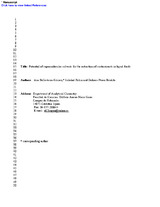Mostrar el registro sencillo del ítem
Potential of supramolecular solvents for the extraction of contaminants in liquid foods
| dc.contributor.author | Ballesteros-Gómez, A. | |
| dc.contributor.author | Rubio Bravo, Soledad | |
| dc.contributor.author | Pérez-Bendito, Dolores | |
| dc.date.accessioned | 2023-12-19T08:08:20Z | |
| dc.date.available | 2023-12-19T08:08:20Z | |
| dc.date.issued | 2009 | |
| dc.identifier.uri | http://hdl.handle.net/10396/26384 | |
| dc.description.abstract | Supramolecular solvents, which are water immiscible liquids consisting of supramolecular aggregates in the nano- and micro-scale regimes dispersed in a continuous phase, were assessed for the extraction of trace contaminants in liquid foods. The SUPRAS selected was made up of reversed micelles of decanoic dispersed in tetrahydrofuran (THF)–water and the contaminants used as a model were bisphenol A (BPA), ochratoxin A (OTA) and benzo(a)pyrene (BaPy). The influence of matrix components on the extractant solvent production, extraction recoveries and actual concentration factors was investigated by using commercial foods such as wine and wine-based products, beer, soft drinks and tea and coffee brews, and/or aqueous synthetic solutions containing specific food matrix components. The method involved the addition of decanoic acid (80 mg) and THF (0.8–1.7 mL) to the food sample (15 mL), stirring of the mixture for 5 min, centrifugation for 10 min and analysis of 10–20 uL of the extract by liquid chromatography coupled to fluorimetry for OTA and BaPy or to mass spectrometry for BPA. No clean-up of the crude extracts was required for any of the samples analysed. The quantification limits for the contaminants (14–31 ng/L, 0.37–0.39 ng/L and 562–602 ng/L for OTA, BaPy and BPA, respectively) were far below their respective European legislative threshold limits. Recoveries for food samples were in the ranges 79–93%, 90–96% and 78–82% for OTA, BaPy and BPA, respectively, with relative standard deviations ranging from 1 to 7%, and actual concentrations factors between 65 and 141. The methods developedwere applied to the determination of the target compounds in a variety of commercial foods. OTA was found in vinegar, must and beer samples, the concentrations ranging from 92 to 177 ng/L, BaPy was quantified in samples of tea and coffee at concentrations between 1.5 and 16.6 ng/L whereas BPA was detected in two canned soft drinks and quantified in one of them (tea beverage) at a level of 2.3 ug/L. | es_ES |
| dc.format.mimetype | application/pdf | es_ES |
| dc.language.iso | eng | es_ES |
| dc.publisher | Elsevier | es_ES |
| dc.rights | https://creativecommons.org/licenses/by-nc-nd/4.0/ | es_ES |
| dc.source | Ballesteros‐Gómez, A., Rubio, S., & Pérez‐Bendito, D. (2009). Potential of supramolecular solvents for the extraction of contaminants in liquid foods. Journal of Chromatography A, 1216(3), 530-539. https://doi.org/10.1016/j.chroma.2008.06.029 | es_ES |
| dc.subject | Supramolecular solvents | es_ES |
| dc.subject | Liquid-liquid extraction | es_ES |
| dc.subject | Food analysis | es_ES |
| dc.subject | Ochratoxin A | es_ES |
| dc.subject | Bisphenol A | es_ES |
| dc.subject | Benzo(a)pyrene | es_ES |
| dc.subject | Liquid chromatography | es_ES |
| dc.subject | Mass spectrometry | es_ES |
| dc.subject | Coacervates | es_ES |
| dc.subject | Self-assembly | es_ES |
| dc.title | Potential of supramolecular solvents for the extraction of contaminants in liquid foods | es_ES |
| dc.type | info:eu-repo/semantics/article | es_ES |
| dc.relation.publisherversion | https://doi.org/10.1016/j.chroma.2008.06.029 | es_ES |
| dc.relation.projectID | Gobierno de España. CTQ2005-00643 | es_ES |
| dc.relation.projectID | Gobierno de España. AP2005-4275 | es_ES |
| dc.rights.accessRights | info:eu-repo/semantics/openAccess | es_ES |

